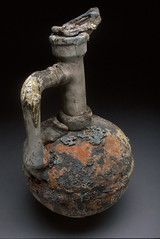
On October 6, 2007, the
Daum Museum of Contemporary Art will open a solo exhibition by Peter Callas entitled, Sparks.
Charlemagne
2003, woodfired stoneware, 48″ x 24″ x 24″
From the Daum Museum website:
Peter Callas is a ceramic sculptor working in the tradition of abstract expressionism who has produced a repertoire of sculpted images grounded in the Zen aesthetic. He is one of the foremost sculptors working in clay utilizing the anagama kiln to produce large scale expressionist forms. For many years he fired the works of the preeminent American clay artist Peter Voulkos in his New Jersey kiln and traveled extensively worldwide with Voulkos as his assistant. Today he is considered to be one of America’s foremost authorities on the wood fire anagama kiln tradition. He has found his own voice influenced by Voukos but uniquely original. He has exhibited extensively in Korea, Japan and Norway and his works are in museum collections in those countries as well as in Hungary, Brazil and numerous American museums including the Daum Museum of Contemporary Art.
The exhibit runs through January 27, 2008. In conjunction with the opening there is a free two-day workshop with Peter that is open to the public: Friday, October 5th, 9:00 am-3:00pm and Saturday, October 6th, 9:00 am-12:00 pm.
A lecture by the artist is scheduled for Saturday, October 6th at 2:00 pm.
A 48-page full-color catalog is availablewith an Introduction by Curator Douglass Freed and an essay “Romancing the Mud” by Ronald Kuchta. To order a catalog, contact the museum.





 On October 6, 2007, the Daum Museum of Contemporary Art will open a solo exhibition by Peter Callas entitled, Sparks.
On October 6, 2007, the Daum Museum of Contemporary Art will open a solo exhibition by Peter Callas entitled, Sparks.
 Ceramic Bowls
Ceramic Bowls 


